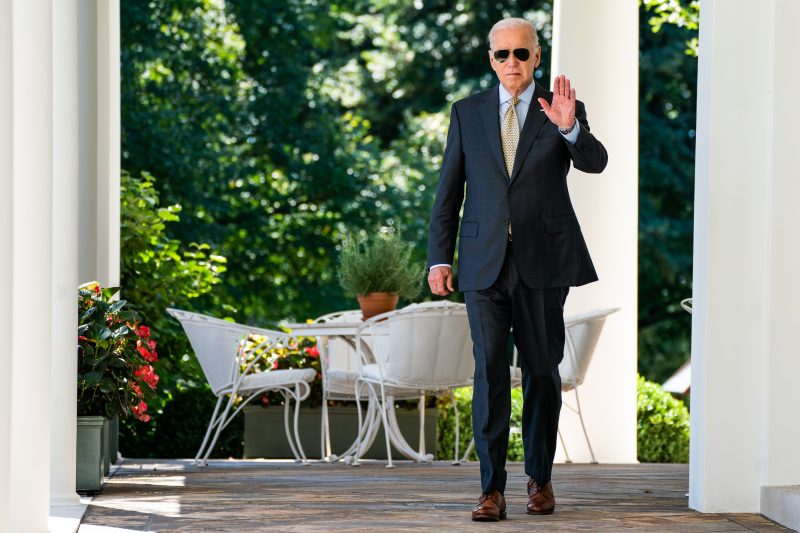Joe Biden is already the oldest president in American history. If he is reelected in 2024, he would be 86 at the end of a second term in office.
His age isn’t actually that unusual. There were 5.5 million people 86 or older in the United States last year, according to Census Bureau data, constituting about 2 percent of the population. But of course, most Americans who are in their 80s are not serving as president of the United States, a job that is unusually stressful even for younger holders of the position.
Two recent polls have shown that Americans are wary of Biden’s age — even relative to his possible (probable, at this point) opponent in 2024, Donald Trump. Trump is slightly younger than Biden but he’d still be older on Inaguration Day in 2025 than Biden was in 2021.
Two recent polls have shown that Biden’s age is more of a concern for voters than is Trump’s. Both the Associated Press (and their polling partners NORC) and the Wall Street Journal have found that three-quarters of Americans (or voters, in the Wall Street Journal poll) view Biden as too old to be president. About half say the same of Trump.
Those Biden numbers are unusual. They’re unusual in part because this isn’t a question that’s commonly asked about presidents, since presidents aren’t usually uncommonly old. (By definition.) But they’re also unusual even within the context of past, older presidents.
When Ronald Reagan was seeking the presidency in 1980, his age became a focus of concern. He was only 69 when inaugurated in 1981, but Americans generally were younger, thanks to the baby boom. So, shortly before the 1980 election, ABC News and its polling partners at Harris and Associates asked whether a president pushing 70 was too old, considering the difficulty of the job. About 4 in 10 said it was.
Harris asked the same question in 1982 with an eye toward Reagan’s 1984 reelection. Was 74 too old? Only half of respondents said it was.
Even by March 1987, only 4 in 10 Americans said Reagan was too old to serve as president. Now, three-quarters say the same of Biden.
There are differences, of course. Biden is older, for one, and while Reagan had his share of gaffes and fumbles, Biden’s have spawned a cottage industry of media attention. His opponents have not only seized on misstatements as evidence of deteriorated mental acuity but elevated noncontroversial occurrences as evidence of his failings.
But there’s a bigger difference, too: Biden is the oldest president in history at a moment when generational tensions are roiling — and he’s the representative of a party for which that tension is particularly acute.
Using voter registration data from the firm L2, we can view the distribution of party registrations and nonpartisan voters by age. (This includes modeled party identification.) The Republican Party skews particularly old; while baby boomers aren’t overwhelmingly Republican, they are more likely to be Republican than are younger voters. The Democratic Party is more uniform in its age distribution, though it reflects the competing power centers of the larger millennial and boomer generations. Nonpartisan voters, meanwhile, are heavily centered at the lower end of the age range.
A third of Democrats and a bit under half of those without a party identification are 40 or younger, compared to only a fifth of Republicans. There’s unquestionably pressure from those younger voters about Biden’s age. In the AP poll, Democrats were about equally likely to say that Biden and Trump were too old. Republicans were three times as likely to say that Biden was.
The challenge for Democrats — and specifically for Biden — is that those younger voters will eventually make up most of the electorate but that they do not currently. Data from the Census Bureau (not corrected for nonresponse bias) shows how turnout rates in 2020 increased as voting age increased. Only once the voting population reached its late 70s did turnout drop off. (The bureau data group ages 80 to 84 and 85 and older as two groups.)
Combining those two charts, the point is made clearly: The Republican Party is more densely centered in the more-heavily voting part of the electorate.
So it’s not just that Biden is viewed skeptically by a party that skews younger than the opposition (and far younger than himself). It’s that turnout from his party and younger independents who often vote Democratic is already lower — and turnout suffers more when people are apathetic about candidates.
Three years ago, Biden won the presidency by beating Trump. Pew Research Center analysis found that the percentage of the electorate that was older than the baby boom — a group that votes more heavily Republican — fell from 16 percent to 8 percent between 2016 and 2020. The percentage that was millennial or younger rose from 23 to 30 percent. In part, that’s a function of the inevitable decline in turnout among the elderly. In part, it was about enthusiasm to see Trump removed from office.
But even if Biden is facing Trump in 2024, he’s not simply the non-Trump option on the ballot. He’s the sitting president, someone with a record of addressing issues that (in the AP poll) younger Democrats view more skeptically. He’s an 80-year-old seeking another four years as president from a party and from a pool of independents that has for years seen its power overwhelmed by older Americans.
Part of Biden’s age problems are specific to Biden, unquestionably. Part of them are rooted in a very familiar old-vs.-young struggle that Biden’s party has not had much success in navigating — even though it’s a struggle that’s particularly sharp within that party.
Lenny Bronner contributed to this report.

